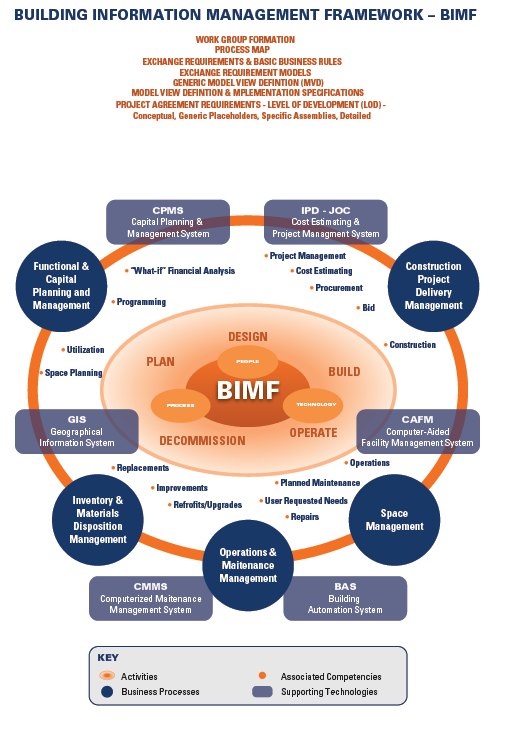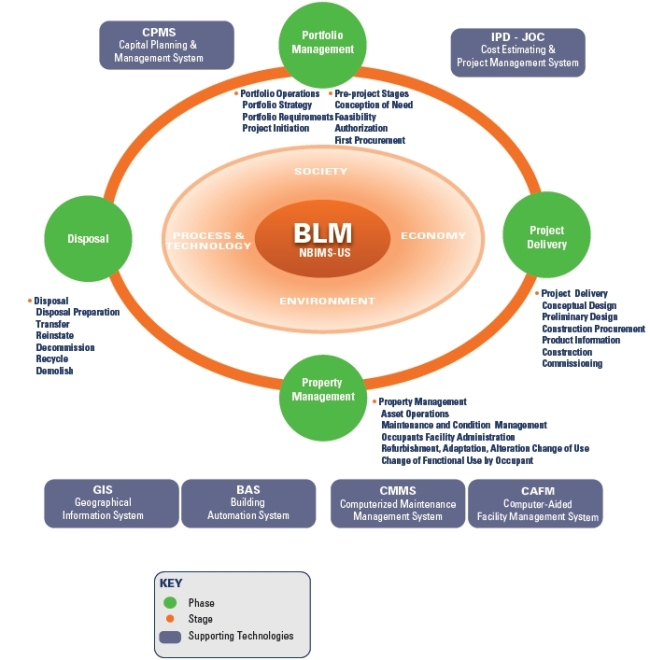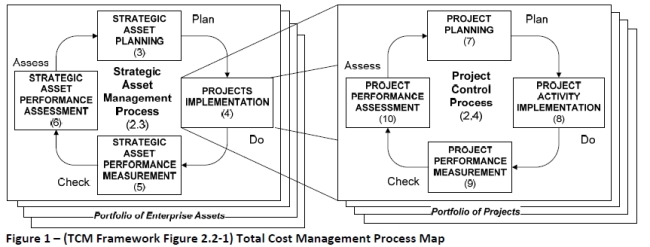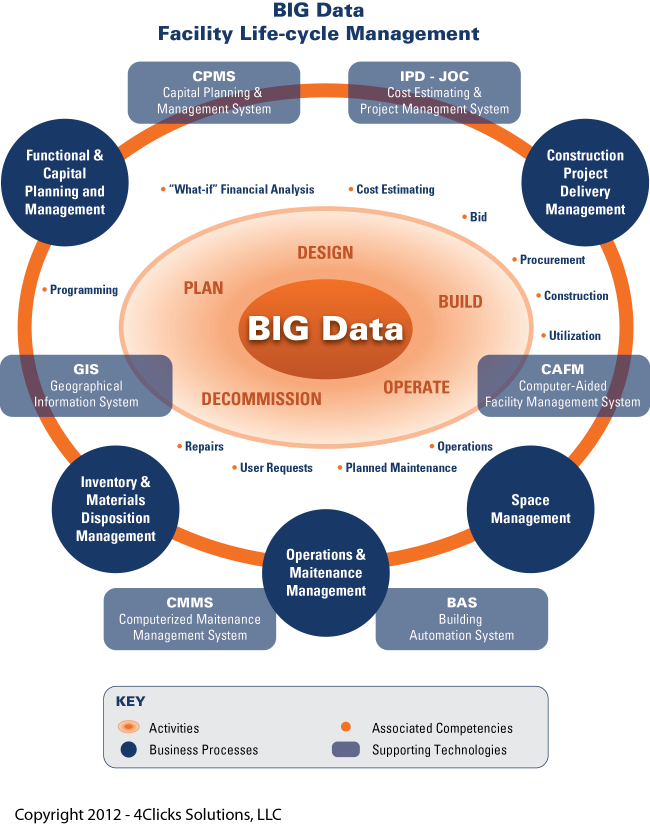- Not speaking the right language.
- Failure to quantify risk, opportunities, productivity, linkages of built environment to organization success/failure.
- First-cost vs. life-cycle cost approach.
- Inability to collaborate internally and externally with services providers, stakeholders.
- Lack of standardized terms, metrics, robust and proven business processes and metrics.
- Following the “traditional/safe” path, i.e. existing legacy technology and/or data project delivery methods (design-bid-build, design-build), vs. integrated project delivery and/or job order contracting).
- Failure to compare in-house and service provider material, equipment, and labor costs with standards such as RSMeans Cost Data.
- Reactionary vs. pro-active approach and methods.
- Failure to adopt agile and continuous improve approaches
- Lack of relevancy.
Tag: metrics
2014 – Owners Need to Step It Up and Get Serious about BIM / BLM – Life-cycle Management of the Built Environment
It’s time for Owners to stop the marketing… Stop hyping their LEED Silver or “Whatever” Buildings… and actually participate in life-cycle management of the built environment supported by digital technology. This is the real BIM / BLM (built-environment life-cycle management) and it’s critical to the financial, economic and mission goals of many/most organizations.
Improved decision making with respect to construction, repair, renovation, operations, and sustainability of the built environment, as well as associated efficient construction project delivery has several basic requirements.
1. Recognition and consistent implementation of built-environment life-cycle management (BLM) “best practices” relative to business processes, workflows, requisite competencies, technologies, information management requirements, and associated metrics.
2. Standardized robust terms, definitions, and inter-relationships for all associated built environment practice areas and/or competencies.
3. A focus upon life-cycle costs vs. first costs in terms finance and environmental impact.
4. Collaborative project delivery methods and practices such as Integrated Project Delivery (IPD), Job Order Contracting, (JOC), and Public Private Partnerships (PPP) vs. traditional ad-hoc and antagonistic methods such as design-bid-build (DBB) or interim methods such as design build (DB).
5. Continuous monitoring and improvement.
Owners pay the bills are ultimately responsible for managing the built environment efficiently. It’s beyond time that many/most Owners get started!
BIM (Building Information Management, Modeling, Model) vs. EVM (Earned Value Managment) vs. TCO (Total Cost of Ownership)
BIM, EVM, TCO (or TCM – Total Cost Management) are all inter-related
BIM is the life-cycle management of the built environment supported by digital technologies.
TCM is effective application of professional and technical expertise to planand control resources, costs, profitability and risks. Simply stated, it is a systematic approach to managing cost throughout the life-cycle of any enterprise, program, facility, project, product, or service. This is accomplished through the application of cost engineering and cost management principles (I assert this aspect is somewhat incorrect…it not only cost engineering and cost managemt principles, but rather the application and integration multi-discipline competencies;…but hey this definition is from the AAECI, so how can I complain?). , proven methodologies and the latest technology in support of the management process. It can also be considered the sum of the practices and processes that an enterprise uses to manage the total life-cycle cost investment in its portfolio of strategic assets. (Source: (PUBLIC REVIEW DRAFT) AACE® International Recommended Practice No. 82R-13 EARNED VALUE MANAGEMENT (EVM) OVERVIEW AND RECOMMENDED PRACTICES CONSISTENT WITH ANSI EIA-748)
EVM has two critical flaws…
1. No mention of the need for collaborative project delivery methods, examples in construction sector being IPD – Integrate Project Delivery and JOC – Job Order Contracting. I argue that EVM is little more than an accounting number crunching exercise unless embedded within a collaborative project delivery methods. (History BTW proves me write on this… just as in the case of ISO 9000, consultant made millions while little true improvement in fundamental business processes was gained).
2. No mention of functional as well as physical metrics. Both are required in terms of a product, building, etc.
So, what is needed?
A complete ontology for each sector (built infrastructure, products, etc.). A life-cycle management strategy noting all required competencies, process, technologies, stakeholder, etc. etc.
For example…
And a rich listing of metrics.
What’s Really Needed to Make BIM Work.
Building Information Management (that’s right forget the “modeling” distraction), BIM, is the life-cycle management of the built environment supported by digital technology.
What is required to accomplish BIM?
1. Commitment, understanding, and knowledge on the part of all stakeholders – Owner, AEs, Contractors, Subs, Product and Service Providers, and Oversight Groups.
2. Robust, collaborative business practices complete with a well defined ontology, metrics, and methods for continuous improvement.
3. Open standard technology (cloud computing, GIS, CPMS, CAFM, Cost Estimating, Project Delivery, BAS, Visualization) that embeds and supports life-cycle management processes.
Simple right? Well actually it is, IF AND ONLY IF, Owners drive the process (they pay the bills, period…not AEs, Contractors, Trades) and Suppliers are willing and capable of working in a collaborative BIM environment (not all will be…FACT).
Now for a few specifics… not in any particular order:
Life-cycle management of the built environment requires the integration of disparate information, parties, domains…etc., each having their own value, contribution, level of permanence, etc. in order to define the scope, schedule, cost/budget (initial and life-cycle) budget, performance, value of a project or potential project.
Progress measurement analysis and control is continuous, as are decision-making and decision-support activities.
Behaviors and domains spans: Organizational, Planning, Budgeting, Accounting, Architecture, Construction, Technology, and Legal. Change management is likely the most significant barrier to entry for BIM, as other issues are trivial in comparison.
Fundamental life-cycle phases and strategies are applicable: Analyze (Develop and maintain measurement tools) , Plan (For progress and performance measurement), Execute (design, procure, construct, maintain, repair, renew, adapt, deconstruction, reuse… track resources, measure progress, track resource, review/report progress … physical and functional aspects).
What “tools” are needed? Well, for starters, a standardized set of the following:
Overall Life-cycle and/or Total Cost of Ownership process and glossary of terms/ontology
Robust, collaborative construction delivery methods (Integrate Project Delivery – IPD, Job Order Contacting – JOC, Private Public Partnerships – PPP)
List of Items and Item Classifications and Parameters (function, measurements, performance, …)
Cost Data Architecture / Cost Classifications / Cost Types – Materials, Equipment, Labor, Environmental, Life-Safety
Metrics: Physical and Functional and associated Assessment Methods and Criteria
Why BIM Isn’t Working.
The construction delivery method sets the tone, establishes the roles and responsibilities of all parties involved, and impacts ultimate success more so than any technology.
Thus IPD – Integrated Project Delivery for new construction and JOC – Job Order Contracting for renovation, repair, sustainability, and minor new construction, and similar collaborative construction delivery methods should be the primary focus. Technology is certainly a deployment enabler, and sometime also a disruptive catalyst.
Stakeholder collaboration (Owners, AEs, Contractors, Subs, Oversight Groups, Building Product Manufactures…) throughout the life-cycle of a build structure is the fundamental element that ultimately drives productivity and better outcomes. Collaboration is the path to the refinement of associated goals, needs, and activities…. and therefore creates requisite focus.
BIM is being held back by one item…. lack of collaboration, or even the willingness to collaborate.
BIM technology vendors and “standards” organizations are somewhat to “blame” , as they have placed emphasis upon 3D visualization vs. construction delivery methods, a robust ontology, and metrics.
The Metrics of BIM – The Manage the Built Environment
As the old saying goes…”you can’t manage what you don’t measure”.
Here’s the beginning of a list of information requirements spanning various domains/competencies, technologies, etc.,
While an important component, the 3D component of BIM has been a very unfortunate distraction. It appears that many/most have “gone to the weeds” and/or are “recreating the wheel” vs. working on core foundational needs such as the consistent use of appropriate terminology and the establishment of robust, scalable and repeatable business practices, methodologies, standards, metrics and benchmarks for facilities and physical infrastructure management.
It is common terminology that enables effective communication and transparency among the various decision makers, building managers, operators and technicians involved with facilities and physical infrastructure investment and management.
Here are examples of metrics associated with the life-cycle management of the built environment:
Annualized Total Cost of Ownership (TCO) per building per gross area = Rate per square foot
Annualized TCO per building/Current replacement value = Percent of Current Replacement Value (CRV)
Annualized TCO per building/Net assignable square feet = Cost rate per net assignable square feet per building
Annualized TCO per building/Non-assignable square feet = Cost rate per non-assignable square feet per building
Annualized TCO per building/Building Interior square feet = Cost rate per interior square foot per building
Churn Rate
Utilization Rate
AI (Adaptation Index) or PI (Programmatic Index) = PR (Program Requirements) /
CRV (Current Replacement Value)
Uptime or Downtime – Defined in percent, as amount of time asset is suitable for the program(s) served.
Facility Operating Gross Square Foot (GSF) Index (SAM Performance Indicator: APPA 2003)
Custodial Costs per square foot
Grounds Keeping Costs per square foot
Energy Costs per square foot
Energy Usage
Utility Costs per square foot
Waste Removal Costs per square foot
Facility Operating Current Replacement Value (CRV) Index (SAM Performance Indicator: APPA 2003)
Planned/Preventive Maintenance Costs per square foot
Emergency Maintenance Costs as a percentage of Annual Operations Expenditures.
Unscheduled/Unplanned Maintenance Costs as a percentage of Annual Operations Expenditures.
Repair costs (man hours and materials) as a percentage of Annual Operations Expenditures
FCI (Facility Condition Index) = DM (Deferred Maintenance) + CR (Capital Renewal)
/ CRV (Current Replacement Value)
Recapitalization Rate, Reinvestment Rate
Deferred Maintenance Backlog
Facilities Deterioration Rate
FCI (Facility Condition Index) = DM (Deferred Maintenance) + CR (Capital Renewal) /
CRV (Current Replacement Value)
AI (Adaptive Index) or PI (Programmatic Index) = PR (Program Requirements) /
CRV (Current Replacement Value)
FQI (Facility Quality Index) or Quality Index or Index = FCI (Facility Condition Index)+ AI (Adaptive Index)
 Via http://www.4Clicks.com – Premier cost estimating and efficient project delivery software for the built environment – , …
Via http://www.4Clicks.com – Premier cost estimating and efficient project delivery software for the built environment – , …





